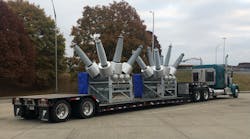I was on a road trip recently, and as we were stopped at a rest area, I saw the truck in the above picture. I am not 100% certain, but I think the truck’s cargo is electric transformers headed for some sort of electrical substation upgrade. That got me to thinking about not just the charging infrastructure that is going to be needed as fleets add more electric vehicles (EVs), but also equipment that will be needed by utility companies in order to make sure they are ready for and can handle the load battery-electric commercial vehicles will put on their infrastructure.
If you notice, the truck in the photo is a diesel. I think it is likely that we are going to see a lot more loads like the one in this truck as the nation builds out a charging infrastructure. And that will be in addition to changes fleets will be making at their depots as well as upgrades utilities will have to make to their facilities. It struck me that this diesel truck was delivering the necessary support that future generations of heavy-duty tractors will need.
That really is good news for fleets as all these materials will have to be transported to a variety of locations, and trucks are going to be the best way to do just that. So, the growth of electric vehicles—cars, buses, and trucks—will help keep trucks busy for at least the next few years and likely decades.
See also: The three paths to decarbonizing trucking
I suppose at some point, some of the components for electric vehicle infrastructure will be moved by EVs. Servall Electric Company, one of the participants in Run on Less – Electric, has served the residential, commercial, and industrial electric needs of the Cincinnati, Ohio area for more than 60 years. One of the things the company was doing was installing electric car chargers, and company management decided that it needed to put its money where its mouth is and so now moves those chargers via an electric vehicle.
But my point here really is that the movement of goods for electrification is going to be a good thing for the trucking industry in terms of added freight volume. And that is on top on the good EVs are going to do for the environment.
Michael Roeth has worked in the commercial vehicle industry for nearly 30 years, most recently as executive director of the North American Council for Freight Efficiency (NACFE). He serves on the second National Academy of Sciences Committee on Technologies and Approaches for Reducing the Fuel Consumption of Medium and Heavy-Duty Vehicles and has held various positions in engineering, quality, sales, and plant management with Navistar and Behr/Cummins.
This article originally appeared on FleetOwner.com.



